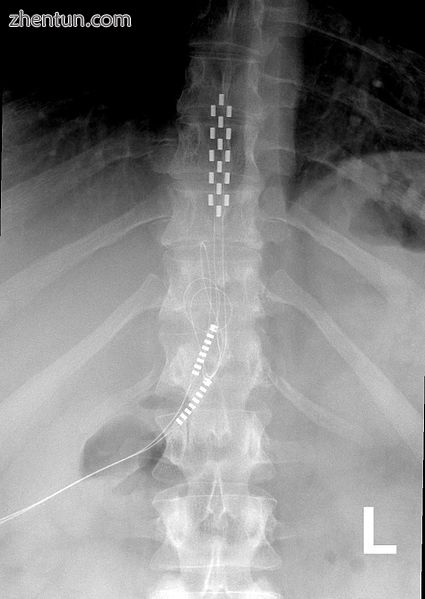视频:↓ 2分钟神经科学_脊髓外侧
https://cache.tv.qq.com/qqplayerout.swf?vid=j08769arwy5
脊髓刺激器(SCS)或背柱刺激器(DCS)是一种植入式神经调节装置(有时称为“疼痛起搏器”),用于将电信号发送到脊髓的选定区域(背侧柱)。 治疗某些疼痛情况。 对于那些对更保守疗法没有反应的疼痛病人,SCS是一个考虑因素。[1]
在美国,失败手术综合症是最常见的用途,而在欧洲,最常见的用途是外周缺血。[2]

脊柱刺激器(SCS)的前视X射线植入胸椎
目录
1 医疗用途
2 禁忌
3 不良反应和并发症
4 行动机制
5 手术程序
6 患者筛查
7 试用期
8 历史
9 研究
10 参考
医疗用途
SCS最常见的用途是美国失败的背部手术综合征(FBSS)和欧洲的外周缺血性疼痛[3] [4]。
截至2014年,FDA已批准SCS治疗失败的背部手术综合征(FBSS),慢性疼痛,复杂局部疼痛综合征,难治性心绞痛,以及内脏腹部和会阴部疼痛[1]以及四肢神经损伤引起的疼痛[5]。
一旦一个人进行了心理评估并被认为是SCS的合适候选人,就会进行临时植入,称为试验,以确定最佳刺激模式,并使用外部脉冲发生器将该人送回家三到十天。如果实现了疼痛控制和活动增加,就会放置一个带引线和脉冲发生器的永久系统。[4]
禁忌
对于患有凝血相关疾病或正在接受抗凝治疗的人,SCS可能是禁忌的。[1]其他禁忌症包括局部和全身感染,心脏起搏器,或那些手术前成像研究显示有解剖结构使得安置困难,或者在心理评估期间出现问题的人。[6] [7] [8]
不良反应和并发症
SCS的并发症包括简单易于纠正的问题,破坏性的麻痹,神经损伤和死亡。在7年的随访中,总并发症发生率为5-18%。最常见的并发症包括铅迁移,铅断裂和感染。其他并发症包括脉冲发生器旋转,血肿(皮下或硬膜外),脑脊液(CSF)漏,硬脑膜穿刺后头痛,脉冲发生器部位不适,血清肿和短暂性截瘫[9]。
有些人发现SPS引起的刺痛感是令人不快的。
最常见的硬件相关并发症是引线迁移,其中植入的电极从其原始位置移开。有了这种并发症,可以通过重新编程来重新获得感觉异常的覆盖率。[10]在涉及主要铅迁移的情况下,可能需要重新开始重置铅放置。[11]在报告有铅迁移的人的百分比方面,研究差异很大,但大多数研究报告的脊髓刺激的铅迁移率为10-25%。[11]
行动机制
脊髓刺激的神经生理学作用机制尚不完全清楚,但可能涉及通过改变中枢神经系统的疼痛处理来掩盖疼痛感和刺痛感。[12]当SCS应用于神经性疼痛状态时镇痛的机制可能与因肢体缺血引起的镇痛有很大不同[13] [14]。在神经性疼痛状态中,实验证据表明SCS改变了背角的局部神经化学,抑制了神经元的过度兴奋。具体而言,有一些证据表明GABA释放水平增加,血清素可能会抑制某些兴奋性氨基酸水平,包括谷氨酸和天冬氨酸。在缺血性疼痛的情况下,镇痛似乎源于氧需求供应的恢复。这种作用可以通过抑制交感神经系统来介导,尽管血管舒张是另一种可能性。也可能涉及上述两种机制的组合。[15]
外科手术
脊髓刺激器分为两个不同阶段:试验阶段,然后是最后植入阶段。首先,利用无菌技术准备和覆盖皮肤。硬膜外腔通过使用14号Tuohy针的失去阻力技术进入。通过荧光镜引导将导线小心地送入适当的脊柱水平。重复该过程以将另一个引线放置在第一个附近。在手术过程中经常使用荧光检查来确定SCS引线的正确放置。引导位置取决于患者的疼痛位置。根据以往的研究,腰痛患者的铅位置通常为T9至T10。然后,设备技术人员将开启刺激,通常以非常低的频率开始。提示患者描述通过激活引线感知的感觉,并且技术人员将校准SCS以实现患者的目标疼痛区域的最大感觉异常覆盖。最后,将引线固定在外部,以降低铅迁移的风险,清洁部位,并使用干净的敷料。一旦患者从手术中恢复,该装置再次进行测试和编程。[16]
病人筛查
作为刺激物放置候选者的患者应筛查禁忌症和合并症。在刺激试验之前应考虑以下因素:[1]
出血风险 - 脊髓刺激器试验和植入物已被确定为具有严重脊柱内出血风险的程序,其可导致永久性神经损伤。在放置刺激器之前,必须适当规划停用和重新使用抗血小板和抗凝血药物。
心理评估 - 抑郁,焦虑,躯体化和疑病症与脊髓刺激器的恶化结果相关。专家建议在安置前进行心理评估。精神疾病的诊断并不是刺激物放置的严格禁忌症。然而,指出在考虑试验放置之前治疗疾病。
延迟放置 - 如果在慢性疼痛发作多年后放置刺激器可能效果不佳。对400例患者进行的一项综述发现,疼痛发作后15年内刺激因子的成功率仅为9%,而在疼痛发作后两年内接受刺激的患者接近85%[17]。
技术难度 - 无论是先天性还是后天性,解剖结构的变化可能妨碍在某些个体中成功放置。脊柱成像对于指导脊柱手术比刺激器放置更合适的候选者的选择是必要的。
试用期
为了在植入前评估脊髓刺激器的功效,必须进行试验。该试验首先将临时导线放入硬膜外腔并经皮连接到外部发生器。该试验通常持续3-7天,然后在SCD植入前缓解2周,以确保试验中没有感染。[11] [18]成功试验的定义是疼痛减轻至少50%,原始疼痛区域80%感觉异常重叠。如果患者的疼痛突然发生变化,则需要进一步调查可能的铅迁移或刺激器故障。[7]
历史
Melzack和Wall在1965年提出了门控制理论后不久开始通过神经刺激进行电痛治疗。该理论认为携带疼痛外周刺激的神经和携带触觉和振动感觉的神经都终止于脊髓的背角(门)。 19]据推测,对后者的输入可以被操纵以“关闭”前者的门。作为门控理论的应用,Shealy等人[20]第一个脊髓刺激器装置直接植入背柱用于治疗慢性疼痛,1971年,Shimogi及其同事首次报道了硬膜外脊髓刺激的镇痛特性。从那以后,这项技术经历了许多技术和临床开发。
此时,用于治疗疼痛的神经刺激与神经刺激,脊髓刺激,深部脑刺激和运动皮层刺激一起使用。
研究
SCS已在帕金森病[21]和心绞痛患者中进行过研究[22]。
改进设备和软件的研究包括努力增加电池寿命,努力开发闭环控制,以及将刺激与植入的药物输送系统相结合。[21]
2018年8月,欧盟委员会的“地平线2020未来与新兴技术”计划宣布为这个四国项目团队提供350万美元的资金补助,该团队正在建造一个旨在“重新连接”脊髓的植入物原型。[23] [24]
在2018年9月,梅奥诊所和加州大学洛杉矶分校报告说,通过物理治疗支持的脊髓刺激可以帮助瘫痪的人恢复站立和行走的能力。[25]
另见
Transcutaneous electrical nerve stimulation
参考
McKenzie-Brown, Anne Marie (November 1, 2016). "Spinal cord stimulation: Placement and management". UptoDate.
Eldabe, Sam; Kumar, Krishna; Buchser, Eric; Taylor, Rod S. (July 2010). "An analysis of the components of pain, function, and health-related quality of life in patients with failed back surgery syndrome treated with spinal cord stimulation or conventional medical management". Neuromodulation. 13 (3): 201–209. doi:10.1111/j.1525-1403.2009.00271.x. PMID 21992833.
Turner, J. A.; Loeser, J. D.; Bell, K. G. (December 1995). "Spinal cord stimulation for chronic low back pain: a systematic literature synthesis". Neurosurgery. 37 (6): 1088–1095, discussion 1095–1096. doi:10.1097/00006123-199512000-00008. PMID 8584149.
Patel, Vikram B.; Wasserman, Ronald; Imani, Farnad (2015-08-22). "Interventional Therapies for Chronic Low Back Pain: A Focused Review (Efficacy and Outcomes)". Anesthesiology and Pain Medicine. 5 (4): e29716. doi:10.5812/aapm.29716. PMC 4604560. PMID 26484298.
Song, Jason J.; Popescu, Adrian; Bell, Russell L. (May 2014). "Present and potential use of spinal cord stimulation to control chronic pain". Pain Physician. 17 (3): 235–246. PMID 24850105.
Narouze, Samer; Benzon, Honorio T.; Provenzano, David A.; Buvanendran, Asokumar; De Andres, José; Deer, Timothy R.; Rauck, Richard; Huntoon, Marc A. (May 2015). "Interventional spine and pain procedures in patients on antiplatelet and anticoagulant medications: guidelines from the American Society of Regional Anesthesia and Pain Medicine, the European Society of Regional Anaesthesia and Pain Therapy, the American Academy of Pain Medicine, the International Neuromodulation Society, the North American Neuromodulation Society, and the World Institute of Pain". Regional Anesthesia and Pain Medicine. 40 (3): 182–212. doi:10.1097/AAP.0000000000000223. PMID 25899949.
Deer, Timothy R.; Mekhail, Nagy; Provenzano, David; Pope, Jason; Krames, Elliot; Leong, Michael; Levy, Robert M.; Abejon, David; Buchser, Eric (August 2014). "The appropriate use of neurostimulation of the spinal cord and peripheral nervous system for the treatment of chronic pain and ischemic diseases: the Neuromodulation Appropriateness Consensus Committee". Neuromodulation. 17 (6): 515–550, discussion 550. doi:10.1111/ner.12208. PMID 25112889.
Knezevic, Nebojsa N.; Candido, Kenneth D.; Rana, Shalini; Knezevic, Ivana (July 2015). "The Use of Spinal Cord Neuromodulation in the Management of HIV-Related Polyneuropathy". Pain Physician. 18 (4): E643–650. PMID 26218955.
Hayek, Salim M.; Veizi, Elias; Hanes, Michael (October 2015). "Treatment-Limiting Complications of Percutaneous Spinal Cord Stimulator Implants: A Review of Eight Years of Experience From an Academic Center Database". Neuromodulation. 18 (7): 603–608, discussion 608–609. doi:10.1111/ner.12312. PMID 26053499.
Eldabe, Sam; Buchser, Eric; Duarte, Rui V. (2016-02-01). "Complications of Spinal Cord Stimulation and Peripheral Nerve Stimulation Techniques: A Review of the Literature". Pain Medicine. 17 (2): 325–336. doi:10.1093/pm/pnv025. PMID 26814260.
Kumar, Krishna; Buchser, Eric; Linderoth, Bengt; Meglio, Mario; Van Buyten, Jean-Pierre (January 2007). "Avoiding complications from spinal cord stimulation: practical recommendations from an international panel of experts". Neuromodulation. 10 (1): 24–33. doi:10.1111/j.1525-1403.2007.00084.x. PMID 22151809.
Sinclair, Chantelle; Verrills, Paul; Barnard, Adele (2016-07-01). "A review of spinal cord stimulation systems for chronic pain". Journal of Pain Research. 9: 481–492. doi:10.2147/jpr.s108884.
Linderoth, B.; Foreman, R. D. (July 1999). "Physiology of spinal cord stimulation: review and update". Neuromodulation. 2 (3): 150–164. doi:10.1046/j.1525-1403.1999.00150.x. PMID 22151202.
Oakley, John C.; Prager, Joshua P. (2002-11-15). "Spinal cord stimulation: mechanisms of action". Spine. 27 (22): 2574–2583. doi:10.1097/00007632-200211150-00034. PMID 12435996.
Kunnumpurath, Sreekumar; Srinivasagopalan, Ravi; Vadivelu, Nalini (1 September 2009). "Spinal cord stimulation: principles of past, present and future practice: a review". Journal of Clinical Monitoring and Computing. 23 (5): 333–339. doi:10.1007/s10877-009-9201-0. PMID 19728120.
Barolat, G.; Massaro, F.; He, J.; Zeme, S.; Ketcik, B. (February 1993). "Mapping of sensory responses to epidural stimulation of the intraspinal neural structures in man". Journal of Neurosurgery. 78 (2): 233–239. doi:10.3171/jns.1993.78.2.0233. ISSN 0022-3085. PMID 8421206.
Krishna Kumar, Gary Hunter, Denny Demeria, Spinal Cord Stimulation in Treatment of Chronic Benign Pain: Challenges in Treatment Planning and Present Status, a 22-Year Experience, Neurosurgery, Volume 58, Issue 3, March 2006, Pages 481–496, https://doi.org/10.1227/01.NEU.0000192162.99567.96
Linderoth, Bengt; Foreman, Robert D (July 1999). "Physiology of Spinal Cord Stimulation: Review and Update". Neuromodulation: Technology at the Neural Interface. 2 (3): 150–164. doi:10.1046/j.1525-1403.1999.00150.x. ISSN 1094-7159.
Kirkpatrick, Daniel R.; McEntire, Dan M.; Hambsch, Zakary J.; Kerfeld, Mitchell J.; Smith, Tyler A.; Reisbig, Mark D.; Youngblood, Charles F.; Agrawal, Devendra K. (December 2015). "Therapeutic Basis of Clinical Pain Modulation". Clinical and Translational Science. 8 (6): 848–856. doi:10.1111/cts.12282. PMC 4641846. PMID 25962969.
Shealy, C. N.; Mortimer, J. T.; Reswick, J. B. (July 1967). "Electrical inhibition of pain by stimulation of the dorsal columns: preliminary clinical report". Anesthesia and Analgesia. 46 (4): 489–491. doi:10.1213/00000539-196707000-00025. PMID 4952225.
de Andrade, Emerson Magno; Ghilardi, Maria Gabriela; Cury, Rubens Gisbert; Barbosa, Egberto Reis; Fuentes, Romulo; Teixeira, Manoel Jacobsen; Fonoff, Erich Talamoni (January 2016). "Spinal cord stimulation for Parkinson's disease: a systematic review". Neurosurgical Review. 39 (1): 27–35, discussion 35. doi:10.1007/s10143-015-0651-1. PMID 26219854.
Taylor, Rod S.; De Vries, Jessica; Buchser, Eric; Dejongste, Mike J. L. (2009-03-25). "Spinal cord stimulation in the treatment of refractory angina: systematic review and meta-analysis of randomised controlled trials". BMC Cardiovascular Disorders. 9: 13. doi:10.1186/1471-2261-9-13. PMC 2667170. PMID 19320999.
"Radical project aims to bridge spinal cord injuries and give patients control of their limbs". Healthcare IT Australia. 2018-08-24. Retrieved 2018-08-24.
"European Commission funds $3.5 million to develop prototype implant that rewires a spinal cord". Healthcare IT News. 2018-08-23. Retrieved 2018-08-24.
"Spinal cord stimulation, physical therapy help paralyzed man stand, walk with assistance". ScienceDaily. Retrieved 2018-09-25. |